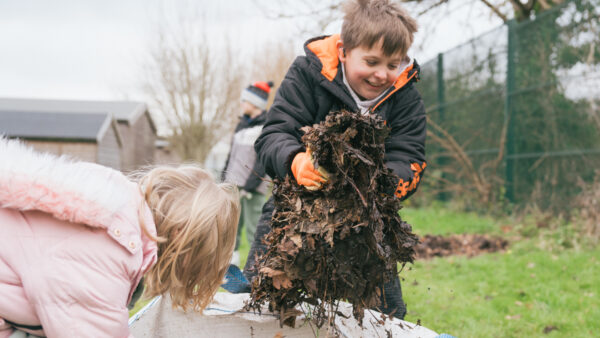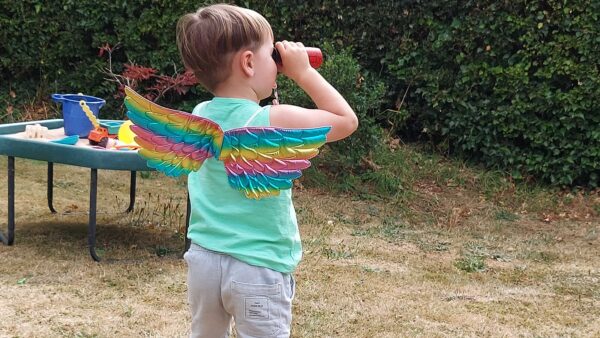What is a sensory garden?
A sensory garden is a space with a principle focus on sensory experience. All landscapes are sensory but some are more sensory than others. It's the concentration of experiences that defines a sensory garden or trail.
Sensory gardens are designed to connect people closely with nature. Some are quiet places, designed to be calming, while others are designed to stimulate activity or to be used within therapeutic or educational programmes.
Why make a sensory garden?
We experience everything through our senses and this creates the multi-sensory memories we carry with us. The more senses we engage, the richer the experience and the more we remember. With imaginative sensory design and sensitive attention to detail, a garden becomes a sensory feast.
What type of space do you need?
Through imaginative design it is easy to create landscapes that offer a wide range of sensory experiences, either as sensory-filled destinations in their own right, or as extra highlights to a more general space.
It often works well to do both. So, if you are planning a sensory garden, you could add sensory richness to the routes that people will use to get there. Or enrich sensory interest generally throughout your site. Or add sensory-rich activities that you can use in the garden or in the wider site.
Planning a sensory garden
Successful sensory garden design relies on a clear idea of what you are aiming to create, why you are doing it, who it's for and how it's going to happen. We recommend that you work through these planning steps before you get involved in the detailed design. The information you collect can be used to share your ideas with others - a project plan will help you sell your project to potential funders and supporters and a design brief will serve as a framework for the detailed design work.
Who is the sensory garden for?
Will it be used by the same people, or by different groups? What is the range of interests and abilities? What are the functional needs - shade, shelter, seating etc. Take account of how this might change in the future. Gather all that you know about potential users, ideally by involving them in the process. If you don't know much about them, find out more - one of the most common mistakes we see is designs based on assumed rather than actual needs.
What are the needs of staff? Can the space provide opportunities for staff to take a break? Is there a need for somewhere where people can smoke?
Bring people together to make plans and share ideas, concerns and experiences. This will get people on board and helps ensure you end up with a design that best meets the needs of the people who are going to use it.
How will the garden be used?
When will people want to use the outdoor space? Think seasonally, weekly and time of day - if evenings are an option then plan to include lighting and ways of people keeping warm (blankets, fires, shelter).
Are there times when it won't be used? In schools there are holidays to consider so don't create a design where the peak of interest (the vegetables are ready, the flowers are out) is in the weeks when there is no-one there to enjoy them.
How many people are likely to use the garden at any one time? Is there a need for individual use as well as bigger groups? Will people be able to choose independently to go outside or will they need others to support them?
Is it feasible to include pets or animals of any sort – rabbits, hens? Even if this is just temporary (some farmers are happy to 'lend' animals).
What do people want to do there? It usually works better to ask people about types of use rather than what things they want to have. What do they really love, hate, get annoyed by? If the garden is mainly for people to relax you need to put a big focus on seating and chill out areas. If it has an important social focus, then include things that bring people together - barbeques, gathering space, fire pit, community gardening area. And if there's a strong educational focus, include elements that link with school curriculum or more informal learning.
What resources do you have?
A useful early step in planning is to review what resources you have to hand already, and where the gaps are. What skills do you need? Who do you know from your networks, and from the local community, who might be able to help? Do you need professional help with all stages of the project or are there some critical inputs that would help?
How will you resource the initial development of ideas, plans and designs? This is likely to include fees for a professional designer, cost of site surveys and production of designs. If you need to fundraise for building the space, it will help to show funders compelling designs that show the quality of your ideas, so investing in plans and creative ways to demonstrate your ideas (sketches, models, photos etc.) at this stage is a good idea.
Construction, planting and furnishing of the garden will be the most costly part of the project. If funds are limited you might decide to phase the development, or to use volunteers to help reduce overall costs. It is crucial to have good project management by someone with experience of construction so you can make sure the work is of high standard and well organised.
Include budget for maintenance and renovation, and for promotional information.
What ideas have inspired your project?
This is the creative bit where you collect ideas and think about what sort of space you want. Browse the internet, journals and magazines and collect pictures of garden designs and design features that you like. Find a spare wall, a board, or a big sheet of card and stick up the pictures so you can all look at them more easily.
How will the garden be maintained?
It is important to consider how your project will be cared for and it will impact on the design - there is no point in creating a garden that requires a lot of regular maintenance work if this isn't going to possible.
Who will be responsible for the maintenance? Will they understand the design and know what to do (e.g. training a willow tunnel/canopy as it grows), and what not to do (e.g. not cutting off lower branches intended for children's play)? Will they need some training?
How will the care of your garden fit in with any existing maintenance programs? Involve existing site managers in the design of your maintenance program.
Will volunteers be involved? There may be people in your local area with useful skills and who might welcome the opportunity to get involved.
Can users get involved? Who will support, motivate and manage them?
Maintenance plan - do you have a maintenance plan? This outlines the work that's required, who is going to do it, and critical timings.
How will the project be managed?
Set up a Working Group - This group will be responsible for running the project so it should include people with authority to make decisions and time to keep things moving forward. If possible include people who will ultimately use the garden.
Identify a project manager. It's important that you have someone who will take responsibility for supervising and managing the work. They must have sufficient experience to deal with the range of technical issues that will arise, and the ability to make decisions quickly.
Find individuals and organisations that can help. Both local and national, identify ones that have useful expertise, who have undertaken similar work already, or who might help raise funds, promote and advocate, help with the design, construction and maintenance.
Get people involved. Listen to and involve intended users at all stages of the project. Getting people involved creatively in realising their own project is empowering for all involved. Putting the focus on how people want to enjoy the area rather than things they want to have will give you a better idea of what you need to include in your design.
Image Credit: RHS



